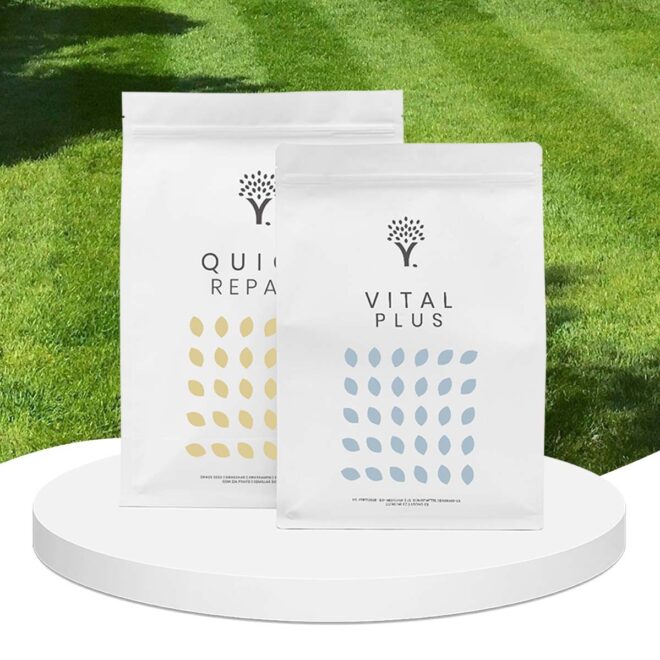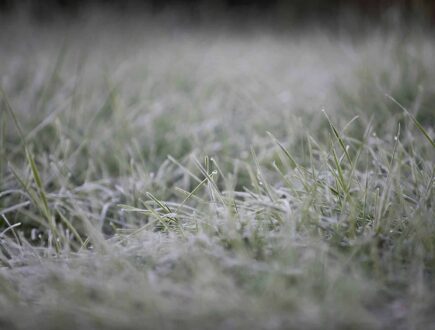Log in or create new account to save this product to your wishlist.

Bee Sustainable! Save money AND the planet with sustainable gardening
Sustainable gardening is about preserving the planet's resources while caring for your outside space. Find out how here.
🌱 All important maintenance moments for your lawn during the year. Leave your email and we will send you the lawn calendar for free.
Enter your email
Receive the lawn calendar in the mail
Enjoy a green lawn all year round!

- Order by 2PM = shipped today
- 250.000+ satisfied customers!
- 60 day satisfaction guarantee
You might have heard that lawns are bad for the environment. However, it depends on your general gardening practices because — actually — lawns are often a boon for sustainability and biodiversity. Are you practising sustainable gardening?
Sustainable gardening can help combat climate change by focusing on reusing, recycling, and boosting biodiversity in our gardens. After all, we’re all responsible for using less and reusing more — and that includes living in harmony with the wildlife that thrives in and above the soil.
This article explores why sustainability is important in gardening and how you can incorporate good sustainable practices in your gardening methods and lawn care.
What does sustainable mean in gardening?

The Royal Horticultural Society defines sustainable gardening as:
Gardening practices that respect our natural resources without depleting them or causing ecological damage.
So, that means:
- Conserving water
- Choosing natural solutions rather than chemical/pesticide over-use
- Partner planting —for example, onions planted next to carrots repel carrot flies without the need for pesticides
- Encouraging birds and other wildlife into your garden
- Saving peat bogs
How can I make my garden sustainable?

We can improve our gardening sustainability in many ways, and we’ll be looking at each of these in this article.
The principal sustainable methods you can incorporate are:
- Reusing
- Making your own compost
- Greening your roof
- Sustainable garden lighting
- Growing your own veg
- Choosing less thirsty grass types
- Mulching
- Attracting bees
Why is sustainability important in gardening?
We only have one planet, and we’ve done a pretty good job of destroying it over the past hundred-odd years. So, sustainability should be a priority in all facets of our lives.
Let’s look at some ways that we can boost our sustainable gardening practices:
Sustainable gardening: Give Stuff a Second Life

We live a particularly disposable existence in the West — we expect cheap clothes, furniture, food, and energy. And while nothing’s particularly cheap right now, we’ve — perhaps — got into the mindset that cheap things equate to disposable.
The garden is the perfect place to offer a second life for things you might normally throw out. After all, one person’s trash is another’s gold!
Tin cans
Old food cans make:
- Outdoor light features for candles or solar lights
- Plant pots
- Seeding pots
- Storage for gardening tools
Glass bottles and jars
Of course, glass is widely recycled in the UK, but you could also use it in the garden for:
- Path edging — upturned bottles pushed into the ground
- Light shades — fill large bottles with solar-powered lights for outside decor
- Odds-n-sods — glass jars are great for storing nails, screwdrivers, tools, and gardening paraphernalia.
Paper and cardboard
Again, widely recycled in the UK, paper and card are brilliant in the garden for:
- Egg boxes — sewing and growing seedlings
- Signs and labels
- Composting
- Mushroom substrate
- Mulch
Old clothes
The trend for “fast fashion” means that £140m worth of old clothes go into landfill in the UK every year. That’s shocking!
Rather than dump them in landfill, use old clothes in the garden for:
- Training ropes — use old shoelaces or rip old shirts and T-shirts into strips and plait ropes for plant training
- Old clothes are great in the summer for shielding delicate plants from the sun and helping insulate them during winter.
- Old wellies and shoes make perfect plant pots
- Use old clothes to make a scarecrow to protect your crops and plants
Tyres
Vehicle tyres are particularly problematic for the environment, creating particle pollutants that pollute the water table and the air.
Reuse old tyres:
- Naturally waterproof bird bath or feeder
- Pile them on top of each other as a compost bin
- Insect shelters
- Mini veg patch
- Veg patch edging
Miscellaneous
Old carpets could keep flowerbeds and veg patches warm over winter. Old cutlery could be used as plant markers. Broken plates and crockery help create drainage in pots and your soil.
Sustainable gardening: homemade compost

Did you realise that much of the potting soil you buy from DIY superstores and garden centres are up to 70% natural peat?
Peat bogs are one of the planet’s natural carbon sinks, helping the earth absorb the CO2 that’s released into the air. And this precious natural resource releases that stored carbon whenever it’s disturbed.
Peat isn’t particularly nutritious but provides excellent drainage, which is why it gets used in potting soils.
But there is another way: collect your garden waste and (uncooked) waste food in a compost heap, and create natural (and free) soil improver/potting soil.
Composting is the process of organic decomposition — worms, insects, bacteria and other organisms convert your waste fruit, veg, and garden waste into super-nutritious soil for your garden.
Alternatively, collect autumnal leaves from your lawn and turn them into gardener’s gold: leaf mould.
Sustainable gardening: Greening Your Roof

Flat roofs make excellent green spaces, offering succulents (such as sedum), herbs, and plants that help clean the air and boost your garden’s biodiversity.
If your home has a flat roof (or you have a shed with a flat roof), consider the benefits of adding more green space in your garden:
- Absorbs rainwater and noise
- Excellent insulator in winter
- Amazing heat repellor in summer
- Helps purify the air and lowers the ambient temperature in your garden
- Fire resistant
- Lasts two to three times longer than a conventional roof
Sure, green roofs are relatively pricey to build, but the benefits for wildlife and the green spaces in and around your home are priceless.
Sustainable gardening: Lighting
It’s lovely to have good garden lighting, which helps extend your garden’s usefulness during those balmy summer evenings. However, some lighting options are more sustainable than others.
For example, old-school incandescent filament bulbs use at least five times the energy of LEDs. And the bulbs we used to refer to as “energy-saving bulbs” contained mercury, which is toxic to the environment.
LEDs offer high illumination for little power consumption and last longer than traditional light bulbs. So, go LED to save money (and keep the planet from burning up!).
Alternatively, of course, there’s solar lighting. And while solar lighting isn’t usually powerful enough for high-level lighting, it makes gorgeous ambient lighting without consuming mains electricity.
Sustainable gardening: Grow Your Own Fruit and Veg
One of the best things bout growing your own fruit and veg is that you know precisely where it came from and what has been used to nurture the plants.
And while growing your own fruit and veg is fun, it can also help bring down your food bills.
Most gardens have limited space for fruit and veg, so consider the food items that are either expensive or difficult to get hold of in your local supermarket. And while it’s tempting to grow potatoes and tomatoes (because they’re relatively easy), perhaps consider growing more unusual crops that are expensive to buy and difficult to source, such as:
- Jerusalem artichokes — absolutely delicious and super easy to grow in abundance, requiring no-to-low maintenance
- Courgettes — easy to grow and prolific fruiters
- Horseradish — amazingly easy to grow once established
- Broad beans — expensive to buy in the supermarkets, broad beans are super-simple to grow
- Rocket — once established, allow the plant to go to seed at the end of the season, and it will grow year after year
Sustainable gardening: Water-Saving Grass Seed Varieties

- Rapid growth – results in 7-14 days
- Stable over-wintering
- AquaSaver coating helps use 34% less water
One of the most significant objections to lawn growing is the water it takes to maintain grass plants. However, in the UK, we get plenty of rain throughout the year, so it’s possible to water your lawn from a water butt — just install a water butt pump and connect your sprinkler.
Nonetheless, a newly sown lawn is very thirsty, requiring around an annual 1100 litres of water to thrive.
And this is why MOOWY has introduced an AquaSaver coating on our Quick Repair grass seed. AquaSaver protects and nourishes the germinating seed, containing tons of micronutrients and humic acids while requiring 34% less water than standard seed. It also germinates up to 20% faster.
Win-win.
You can also find out AquaSaver coating in our Dry Lawn Restore Kit.

- Quick Repair lawn seed uses 34% less water than standard seed
- All-Round Fertiliser with extra potassium for greater resistance
- Restores your lawn after drought
Sustainable gardening: Mulching
Mulching keeps your garden soil warm during winter and minimises water evaporation in hot weather, meaning you’ll need to water your plants less often.
Additionally, mulching helps keep your flowerbeds tidy and suppresses those pesky weeds, so it’s an all-around great sustainable practice.
So, rather than throwing out grass clippings, fallen leaves, wood chips, or tree bark, spread them across your flowerbeds to protect your plants while offering nutrition as it decomposes over the winter.
Check out our expert’s guide to garden mulch.
Sustainable gardening: Create a Bee-Friendly Garden

Things are looking pretty bleak for our valuable pollinators. According to Friends of the Earth, 13 bee species have disappeared since 1900, with another 35 under threat of extinction. And, across Europe, 10% of the bee population faces extinction.
This is a disaster for the entire planet, as we’re losing our natural pollinators, which — of course — arable farming is almost entirely reliant upon.
Fortunately, we can help our local bees survive by offering them food and a safe home.
And this is what we can do:
Nourishment
Bees look for food (pollen and nectar) all year round, so plant a range of plants that can feed them, including:
- Campanula
- Comfrey
- Delphinium
- Foxglove
- Hardy geranium
- Honesty
- Hollyhock
- Potentilla
And you might be surprised to discover that bees seek out food during the winter, so plant the following winter-flowering plants:
- Mahonia
- Heathers
- Winter Honeysuckle
- Winter Aconite
- Hellebores
- Snowdrop
Safety
Bees seek shelter in trees and shrubs and messy garden corners. So, before clearing up the mess from your garden, ensure that your local bees haven’t chosen the spot for shelter.
Also, keeping your garden poison-free helps create a safe environment for the bees.
How to Build your own Bee Hotel
Consider investing in a bee hotel. Don’t worry — they’re cheaper than a night in Claridges! And they’re straightforward to make.
What you need:
- A thick wood stump or block
- A drill
How to build your bee hotel:
Drill holes of different widths (2-9mm) and depths (5-15mm) into the wood. This makes the hotel suitable for diverse species. Avoid drilling all the way through the wood.
Drill the holes at a slight upward angle so rainwater won’t drip into the holes. And then hang it or attach it to a tree — don’t put it on the ground; bees prefer to stay off the floor.
And hey presto — your own bee hotel (and a plentiful supply of pollinators come summer.
Do you have questions?
We hope you feel inspired to adopt sustainable gardening methods. If you have any questions, please get in touch.
We love to hear from you and will reply as soon as we can.
Thanks for reading.
-
Zero-Waste Gardening – This is How You Do It!Did you know that the average person wastes between 100 and 150 kilos of food every year? That's why the concept of zero-waste gardening is becoming increasingly important for environmentally conscious gardeners that like to do their gardening greener.Read more
-
How to Master Tree Pollarding: A Practical GuidePretty dense! What might be an insult to some, is certainly a compliment to trees. Through pollarding, you can make sure, your trees have a dense crown of beautiful leaves.Read more
-
Get Ready: Here are 5 Garden Trends for 2025Curious about the latest garden trends for 2025? From smart solutions to sustainable choices, discover all the outdoor trends that are transforming British gardens!Read more
-
How to Care for Plants in Winter: A Simple GuideWhen winter comes around, the care requirements of your plants change. Find out, how to adjust the care routine for your plants.Read more
-
Companion Planting Made Easy: A Step-by-Step TutorialStrategic plant partnerships can solve common gardening problems like pest invasion and disappointing yields. Find out which plants are great together in our companion planting guide.Read more
-
How to Grow Sweet Potatoes in Your GardenWant to know something splendid? A single sweet potato plant can produce 5 to 10 pounds (4.54 kg) of nutritious tubers—plenty to keep your family’s pantry well-stocked for weeks!Read more
-
Revive Your Lawn After Winter With These Easy StepsTired of winter lawn damage? Discover how to repair brown spots, remove weeds, and revitalise your grass for a thriving garden this spring.Read more
-
A Complete Guide On Lighting for Your House PlantsAchieve perfect lighting for houseplants! This guide covers light mapping, plant placement, and grow light tips to help your plants flourish indoors.Read more
Leave a comment
Your answer will be displayed on the site and the interested party will be notified by email.
Leave a comment
Have a question or want to share your experience? Leave us a comment.

- Order by 2PM = shipped today
- 250.000+ satisfied customers!
- 60 day satisfaction guarantee

- Order by 2PM = shipped today
- 250.000+ satisfied customers!
- 60 day satisfaction guarantee

- Order by 2PM = shipped today
- 250.000+ satisfied customers!
- 60 day satisfaction guarantee

🌱 All important maintenance moments for your lawn during the year. Leave your email and we will send you the lawn calendar for free.
Enter your email
Receive the lawn calendar in the mail
Enjoy a green lawn all year round!





















Comments (0)
There are no comments yet. Well then, what are you waiting for to
Be the first to write your comment!inaugurate this pretty page?
Do you have some comments?